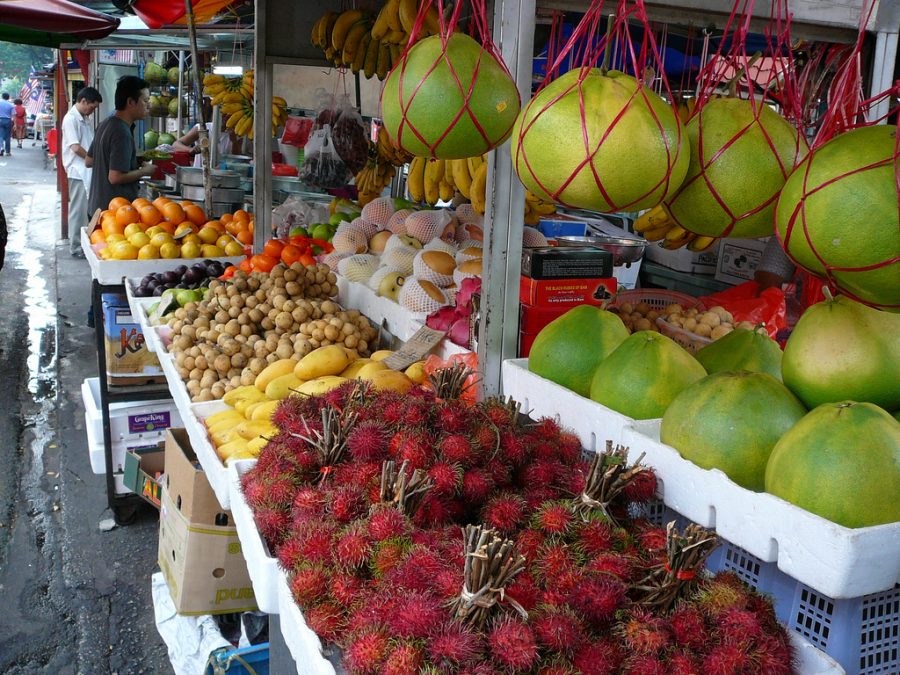Malaysia is located in the heart of Southeast Asia. The South China Sea divides the country into two parts: the mainland, stretching between Thailand and Singapore, and the island, in Borneo, where Malaysia borders on Indonesia and Brunei.
In Malaysia, for vegetarian food fans, a whole world of tastes and new sensations would be opened. In the country, there is a chain of vegetarian Buddhist restaurants, called “Banana Leaf”. There you will be offered South Indian cuisine. In such eateries, not only the dishes are unusual, but also the ceremony of eating without table settings and unnecessary conventions.
Warm and humid tropical climate abounds in sunny days and promotes the growth of a wide variety of exotic fruits, which you are able to try, having rent a car in Langkawi Airport.
The choice of fruits in Langkawi is typical for southeastern Asia, and, this variety is huge. Here you can find almost any fruit (depending on the season). All the fruits described in the article, could be found on the Malaysian fruit markets. We advise you to visit local markets, which are located a little further from the tourist areas, as the prices would be lower there. The fruits, which seem ordinary for us (apples, pears, grapes), are imported from other regions to Malaysia. Therefore, their prices are quite high.
Fresh fruits are often used for the preparation of Malay cuisine dishes. Freshly squeezed fruit juices could be found in the menu of almost every restaurant and street cafe.
Pitaya, mangosteen, tamarillo, durian, snake fruit (salak), and much more exotic names here, would amaze and become the discoveries for your taste sensors. Every day you will enjoy a new variety of fruit flavors. There are several dozens of tropical fruits in Langkawi. As a rule, each of them has several varieties, and their tastes differ, so, it becomes clear how many new tastes you may try.
Below, there are four most exotic fruits, which can be found on Langkawi.
Lychee
This is a delicious round red fruit, up to 4 cm in diameter. It looks like longan in shape, texture and seed, but with a more intense taste and aroma. Very juicy, sweet, sometimes with sourness. The rind is easily separated from the white-transparent flesh.

Unfortunately, fresh lychee can be found only from May to the end of July. In the rest of the year, it is almost impossible to find this fruit. In the offseason in Asia, you can buy canned lychee in cans or plastic bags in their own juice or coconut milk.
Ripe fruit is stored in the refrigerator for up to two weeks. You can store peeled fruits in the freezer for 2-3 months.
Lychee contains many proteins, potassium, pectin substances, vitamin C and magnesium. A very high content of nicotinic acid (a vitamin PP) actively prevents the development of atherosclerosis. The widespread prevalence of lychee fruit in Southeast Asia is the reason of the low level of atherosclerosis in this region.
Snake Fruit (salak)
The fruits are round or pear-shaped, tapering to the top, covered with a scaly brown rind, resembling snakeskin. That is the reason, why it is called ‘a snake fruit’.

The rind is thin and easily removable, it is enough to cut it or tear it at the edge, and then remove it like a shell from an egg. The flesh is white or beige in color and consists mainly of three segments. If the fruit is not ripe, a dry feeling in the mouth appears, because of the high content of tannin.
In Langkawi, there are two varieties of salak. The first consists of three identical segments of elongated shape. It has a refreshing pleasant sweet taste, close to pineapple and banana’s taste, in addition- with a slight nutty taste. The second, which shape is more rounded, tastes similar to gooseberry and pineapple.
Salak contains tannin, which removes harmful substances from the body, has astringent, hemostatic and anti-diarrheal properties.
Dragon fruit (pitaya)
It belongs to the cactus family. Thanks to its unusual shape, as well as to bright pink color, the fruit is very popular among tourists. The flesh of the fruit is creamy and delicate, with slightly perceptible aroma. It could be red or white (depending on the variety), and thanks to it sweet taste, pitaya is eaten raw.
Langsat
The fruits of langsat look like small potatoes, but are slightly larger and are more yellowish. When langsat is peeled, it looks like garlic.
The fruit has sweet and sour unusual taste. It is rich in vitamin C, calcium, phosphorus and carbohydrates. It is also possible to use the rind of langsat. If you burn it, you feel a fragrant scent that is not only pleasant, but also useful, as it serves as an excellent repellent. This fruit could be found only during a couple of months- from April to June.
Fresh fruit can be stored in the fridge for about 5 days.



